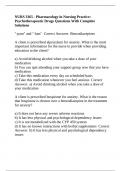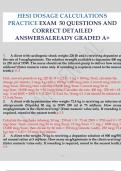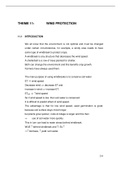Unit 13c&d: Applications of Inorganic Chemistry
Introduction
Welcome to my report, for this report I aim to provide a detailed overview of the characteristics and
behaviour of transition metal complexes, as well as to present the results of practical experiments
involving these compounds. Transition metal complexes are compounds that contain a metal ion
that is bonded to one or more ligands, and they exhibit a wide range of properties and behaviours
that are influenced by the nature of the metal ion and ligands, as well as by the overall geometry of
the complex.
The objective of the experiment is to observe the colour changes of the transition metal ions and the
formation of precipitates, as well as to record if the precipitates dissolve in the presence of an excess
of reagents.
One important aspect of transition metal complexes is their reactivity. Transition metal complexes
have the ability to go through a variety different of reactions, including substitution reactions, where
one or more ligands are replaced by other ligands, and oxidation-reduction reactions, where the
metal ion gains or loses electrons. We can use these reactions to identify the presence of certain
metal ions. In this report, we will examine the reactions of transition metal complexes in more detail
and discuss how these reactions can be used for analytical purposes.
Definitions
Complex ions: A complex ion is a type of ion in which a transition metal is bonded to other ions or
molecules through dative covalent bonds. The transition metal is at the centre of the complex ion
Ligand: Molecules or ions that are bonded to a central metal ion or atom through a coordination
covalent bond, which is a type of chemical bond that involves the sharing of electron pairs between
the ligand and the central atom. Ligands are usually neutral and are characterized by their ability to
donate a pair of electrons to the central atom.
Co-ordination Number: The coordination number of an atom refers to the number of bonds that the
atom has with other atoms or molecules. It represents how many other atoms or molecules the
atom is bonded to. For example, if an atom has a coordination number of six, it is bonded to six
other atoms or molecules.
Octahedral: Octahedral: In an octahedral complex, the geometry of the bonds with the central atom
is taken into account, but the changes between the ligands are not. The d subshell equality is not
maintained in this case. The arrangement of the bonds becomes more complex and the metal ion's
coordination number increases to six. An octahedron has eight planes, and a square planar has
ligands above and below the plane.
Tetrahedral: In a tetrahedral arrangement, the central atom is surrounded by four other atoms that
are bonded to it. These four atoms are located at the corners of a tetrahedron. When all four
substituent atoms are the same, the bond angles between them are approximately 109.5 degrees.
The bond angles in a tetrahedral arrangement are determined by the geometry of the arrangement,
, which is influenced by the valence electron configuration of the central atom and the number and
type of substituent atoms bonded to it.
Square planar: In a square planar arrangement, the central atom is surrounded by constituent atoms
such that the corners of a square are formed on the same plane. Transition metal complexes with d8
configurations often have this shape, as the d8 electron configuration is conducive to this
arrangement. The square planar represents the spatial arrangement of the atoms, and the plane
contains multiple sets of orbitals with their own energy levels. These energy levels can be influenced
by various factors such as the type of metal ion and the type and number of ligands that are bonded
to the metal ion, and the overall geometry of the complex.
Octahedral, tetrahedral, and square planar arrangements refer to the geometry of the bonds
between the metal ion and the ligands in a complex ion. An octahedral arrangement is characterized
by the metal ion being bonded to six ligands, which are arranged at the corners of an octahedron. A
tetrahedral arrangement is characterized by the metal ion being bonded to four ligands, which are
arranged at the corners of a tetrahedron. A square planar arrangement is characterized by the metal
ion being bonded to four ligands, which are arranged in a square on the same plane.
These are all important concepts in chemistry, particularly in the study of coordination compounds,
which are compounds that contain a central metal ion or atom bonded to ligands through
coordination bonds.
The term "transition metal" refers to a group of metallic elements located in the centre of the
periodic table. These elements are characterized by the fact that they have partially filled d orbitals
in their ground state. Transition metals are known for their ability to form complex ions, which are
species that contain a central metal ion that is bonded to one or more ligands.
Mercury is not considered a transition metal because has completely filled d orbitals. Instead, it
belongs to a group of elements known as the post-transition metals
Vanadium, on the other hand, is a transition metal. It has five valence electrons, which means that it
has the ability to form five chemical bonds. Vanadium is known for its ability to form complex ions,
which can be used to identify the metal ion present in a sample.
A ligand is a species that donates an electron pair to form a coordinate covalent bond with the
central metal ion in a complex ion. Ligands can be inorganic, such as chloride ions (Cl-), or organic,
such as ethylenediamine (en).
An example of a complex ion is [Fe(CN)6]4-, which contains a central iron(II) ion that is bonded to six
cyanide ions (CN-). The brackets around the formula indicate that the ligands are bonded to the
metal ion through coordinate covalent bonds. The charge on the complex ion is indicated by the
superscript after the brackets.
Octahedral complex ions have a central metal ion bonded to six ligands, which are arranged in a
regular octahedron around the metal ion. An example of an octahedral complex ion is [Co(NH3)6]2+,
which contains a central cobalt(III) ion bonded to six ammonia ligands (NH3).











